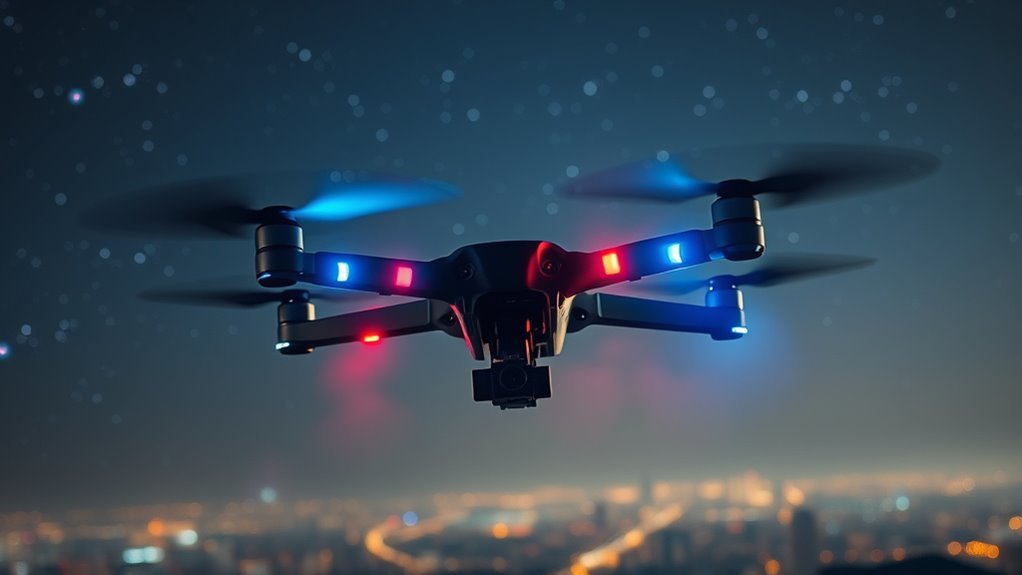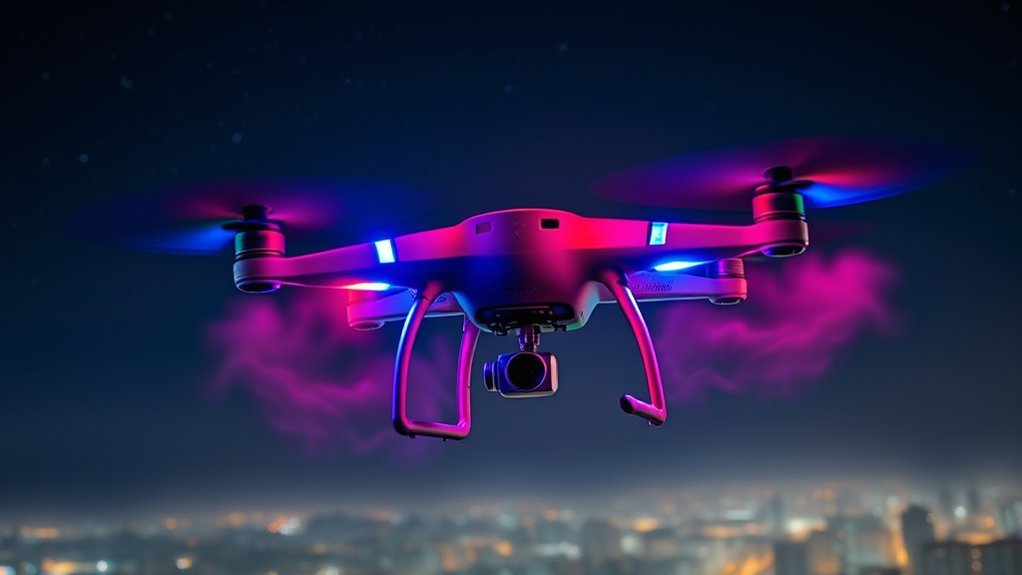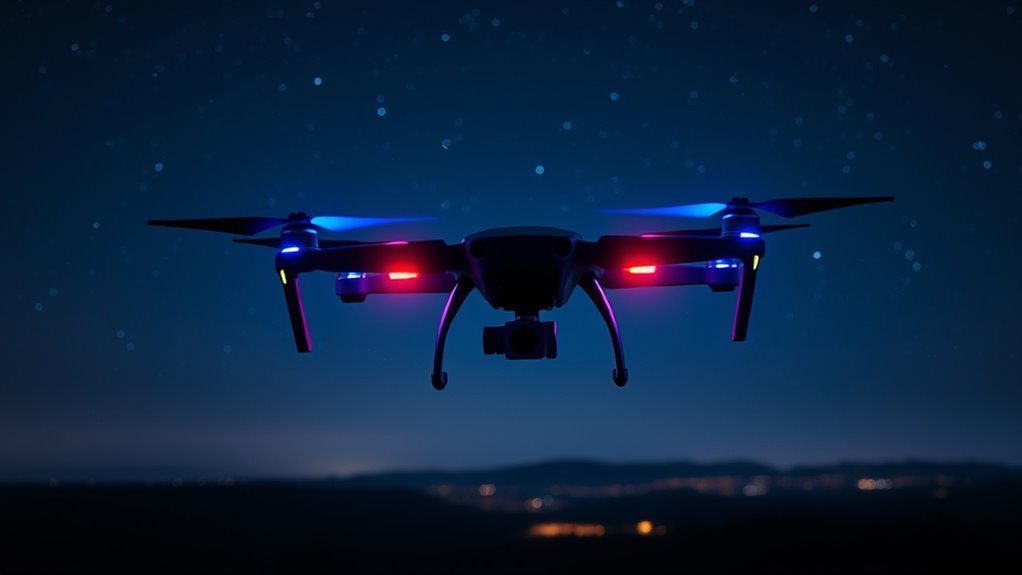At night, a drone takes on an enchanting silhouette, illuminated by a vibrant array of LED lights that dance like stars in the dark sky. Its sleek design merges technology with art, creating a fascinating contrast against the backdrop of night. As it glides, it produces distinct sounds that harmonize with the environment, while its flying patterns mesmerize onlookers. There’s so much more to explore about the technology and safety behind nighttime drone operations.
The Aesthetic Appeal of Drones at Night

As the sun dips below the horizon, drones transform into mesmerizing silhouettes against the night sky, their illuminated frames flickering like distant stars. The drone aesthetics come alive, showcasing sleek designs that merge technology with artistry. You can’t help but feel a thrill as you watch them dance through the darkness, capturing night visuals that paint the canvas of the evening. Each drone’s outline creates a striking contrast against the backdrop, evoking a sense of freedom and exploration. The way they navigate effortlessly through the air highlights their engineering marvels, while the glowing lights hint at possibilities yet to be explored. This fusion of innovation and beauty invites you to experience the night in an exhilarating new way.
Illuminated Features: Lights and Colors

When you gaze up at a drone in the night sky, the vibrant lights and colors it displays are nothing short of enchanting. These illuminated features are not just for show; they serve critical functions in enhancing night visibility. With various LED configurations, drones can communicate their position and intent, ensuring they’re easily spotted. The advanced sensor technology used in drones improves their ability to adjust to environmental changes, enhancing safety during nighttime operations.
| LED Configuration | Purpose |
|---|---|
| Steady White Light | Navigation Assistance |
| Flashing Red/Green | Indicate Direction |
| Color Patterns | Aesthetic Appeal |
These dazzling lights create a mesmerizing spectacle, allowing you to appreciate the blend of technology and artistry. As seen in synchronized choreography during drone shows, the illumination of drones transforms the night into a canvas of colors and purpose.
The Sound of Drones: A Nighttime Symphony

As you stand beneath the starry sky, the sound of drones creates a unique nighttime symphony that dances through the air. Each model produces its own distinct hum, a reminder of the technology hovering above, while environmental factors like wind and terrain shape how those sounds travel. You might find it fascinating how these mechanical melodies vary, blending seamlessly with the nocturnal chorus of nature.
Drones’ Unique Night Sounds
While the night sky is often filled with the tranquil sounds of nature, the whirring of drones introduces a distinct auditory layer that captivates the senses. These drone soundscapes create a unique blend within nighttime acoustics, transforming the familiar serenity into something dynamic and intriguing. As you listen, you might recognize the varying pitches and rhythms that drones emit, from the soft hum of a hovering unit to the more pronounced buzz of one in motion.
| Drone Type | Sound Characteristics |
|---|---|
| Quadcopters | High-pitched whir |
| Fixed-Wing | Low, steady hum |
| Racing Drones | Rapid, sharp buzz |
| Delivery Drones | Soft, distant drone |
This symphony of sounds invites you to explore the skies like never before.
Environmental Impact on Sound
Although you might expect the sounds of drones to dominate the night, their acoustic presence is intricately influenced by environmental factors. The stillness of the evening air can amplify the whirring blades, creating a symphony of drone acoustics that dances with the whispers of the wind. Conversely, nearby traffic or rustling leaves can mask these sounds, blending them into the ambient tapestry of environmental noise. As you listen closely, you might notice how the temperature and humidity shift the tones, altering the perception of a drone’s flight. Shadows of sound emerge and fade, reminding you that even in the technological domain, nature holds sway. Each flight becomes a unique auditory experience, inviting you to embrace the freedom of the night.
Sound Variations by Model
Different drone models produce distinct sounds that can transform a quiet night into a dynamic auditory landscape. You might hear the gentle hum of a DJI Mavic, its propellers creating a soothing drone soundscape, perfect for capturing serene moments. In contrast, the aggressive buzz of a racing drone can feel like a swarm of bees, pulsating with energy and excitement. Model comparisons reveal how design influences sound—larger drones often emit deeper, more resonant tones, while smaller models tend to generate higher pitches. As you listen, each drone’s unique frequency unfolds a story, blending seamlessly with the night. This symphony of sounds invites you to explore the skies, reminding you of the freedom and adventure waiting just above.
Flying Patterns: Drones in Motion
At night, drones exhibit a mesmerizing array of flying patterns that can captivate any onlooker. Their graceful drone maneuvers create a stunning aerial choreography, painting the sky with flickering lights. You might see them zigzagging, hovering, or spiraling, each movement a demonstration of their agility.
| Maneuver Type | Description |
|---|---|
| Zigzag | Quick lateral shifts |
| Hovering | Maintaining a fixed position |
| Spiraling | Circular ascents/descents |
| Synchronized | Coordinated group flights |
As you watch, you’ll feel a sense of freedom and possibility, as if the night sky belongs to these nimble machines. Each pattern tells a story, inviting you to dream of boundless exploration.
Night Vision Technology: Enhancing Visibility
As darkness envelops the landscape, drones equipped with night vision technology become essential tools for exploration and surveillance. These remarkable devices utilize infrared sensors to detect heat signatures, painting a vivid picture of the night. Imagine soaring through the inky blackness, your drone revealing hidden trails and wildlife that would otherwise remain unseen. The glow of its night vision camera transforms the world, turning shadows into shapes and secrets into clarity. With each sweep of the lens, you gain unparalleled insight into your surroundings, empowering you to navigate freely in the dark. Whether for security, wildlife observation, or search and rescue, this technology enhances visibility, granting you the freedom to explore without the constraints of daylight. Moreover, thermal imaging technology can swiftly identify hidden threats in low-light conditions, further enhancing operational efficiency during critical missions. The Teal 2’s superior thermal resolution delivers clearer images, making it particularly effective for detailed analysis in nighttime operations.
The Role of Drones in Nighttime Photography
Drones have revolutionized nighttime photography, transforming how you capture the world after dark. With advanced stabilization and high-resolution sensors, these flying cameras let you explore vibrant cityscapes illuminated by neon lights or serene natural landscapes under a blanket of stars. Drone applications in nighttime photography enable you to achieve stunning long-exposure shots, revealing trails of light and intricate details often missed by the naked eye. You can effortlessly glide above your subjects, capturing unique perspectives that ground-based photographers can only dream of. As you navigate through the night sky, the possibilities are endless, offering you the freedom to express your creativity in the most enchanting ways. Embrace the night, and let your drone redefine your photographic journey.
Drones and Safety: Regulations After Dark
Flying a drone at night opens up a world of stunning visuals, but it also comes with specific regulations you need to follow. You’ll want to guarantee your drone’s equipped with the right safety gear, like anti-collision lights, to stay compliant and safe. Understanding these night flight regulations is essential for a smooth and responsible flying experience.
Night Flight Regulations
While the allure of capturing stunning aerial footage at night can be tempting, it’s essential to navigate the myriad of regulations governing nighttime drone operations. You’ll need to prioritize night flight safety by ensuring your drone is equipped with proper lighting, allowing others to spot you in the dark. Familiarize yourself with local laws, as regulatory compliance can vary widely; some areas may require special permits for night flights. Staying within the visual line of sight is vital, so plan your routes wisely. Understand the airspace restrictions, especially near airports, and always respect privacy concerns. By adhering to these regulations, you not only enhance your freedom to fly but also promote a safer environment for everyone involved.
Safety Equipment Requirements
Before taking to the skies at night, having the right safety equipment is essential to guarantee a smooth and secure operation. To comply with nighttime regulations, your drone should be outfitted with bright, flashing lights to maintain visibility against the dark canvas. A strobe light can serve as a beacon, warning others of your aerial presence. Additionally, equipping your drone with collision avoidance sensors enhances safety, providing an extra layer of protection during low-light conditions. Don’t forget to carry spare batteries, as night flights can drain power quickly. By prioritizing these safety enhancements, you can embrace the freedom of night flying while minimizing risks and guaranteeing a thrilling, yet secure, aerial adventure.
The Impact of Drones on Nighttime Events
As dusk settles and the stars begin to twinkle, the presence of drones at nighttime events transforms the atmosphere in enchanting ways. These aerial marvels glide through the air, their lights creating mesmerizing patterns that captivate onlookers. However, drone visibility challenges manifest under the veil of night, as the devices can easily blend into the darkness, complicating their tracking. Furthermore, nighttime operational limitations restrict their use, often requiring advanced lighting systems and adherence to strict regulations. Yet, when carefully managed, drones can elevate experiences—offering aerial photography, illuminating displays, and even synchronized light shows. This breathtaking fusion of technology and artistry fosters a sense of freedom, allowing you to see events from thrilling new perspectives, even as the night wraps its arms around you.
How to Spot a Drone in the Night Sky
When you’re scanning the night sky, keep an eye out for unusual light patterns; drones often flash in distinct colors that can set them apart from stars and aircraft. You might also catch faint humming sounds as they hover, giving you a clue to their presence. Additionally, observing their altitude and movement can help you determine whether what you’re seeing is indeed a drone or just another celestial body.
Light Patterns Identification
Although spotting a drone in the night sky can be challenging, understanding its light patterns can make identification much easier. When you observe drones, pay close attention to their distinctive light behaviors.
- Flashing Colors: Most drones feature blinking red, green, or white lights, indicating direction and movement.
- Steady Lights: A drone hovering often has steady lights, which can signal it’s maintaining position or preparing for landing.
- Circling Patterns: If you notice lights moving in a circular motion, it may indicate the drone’s surveillance behavior or a search pattern.
Sound Recognition Techniques
While visual cues are essential for spotting drones at night, sound recognition techniques can greatly enhance your identification skills. By honing your sound detection abilities, you can listen for the distinct hum or whirring of a drone’s rotors. Acoustic profiling allows you to differentiate between various drone models based on their unique sound signatures. As you observe the night sky, pay attention to any irregular noises that break the serenity; this could be a telltale sign of a drone nearby. Experiment with closing your eyes to sharpen your auditory senses, focusing solely on the soundscape. With practice, you’ll become adept at pinpointing drones, granting you the freedom to enjoy the night without unwanted aerial observers intruding on your space.
Altitude and Movement
As you gaze into the night sky, understanding a drone’s altitude and movement can be essential for spotting it among the stars. Drones often make altitude adjustments, hovering anywhere from 20 to 400 feet, which can make them harder to detect. Their movement patterns are usually distinct, allowing you to differentiate them from other airborne objects. Here are three key indicators to keep in mind:
- Flashing Lights: Drones typically have LED lights that flicker or change color, often indicating their direction.
- Steady Hovering: If you spot a stationary light, it might be hovering at a lower altitude.
- Zigzag Motion: Unconventional flight paths, like sudden turns or rapid ascents, are telltale signs of a drone in action.
Future Innovations: Drones Designed for Night Use
Innovations in drone technology are rapidly advancing, especially when it comes to night operations. Imagine soaring through the darkness, guided by drones equipped with cutting-edge night vision and thermal imaging. These enhancements allow you to detect heat signatures and navigate effortlessly through low-light environments. Future drones will integrate AI algorithms to predict movements and adapt to changing conditions, giving you unparalleled control. With sleek designs and LED indicators, these drones will glow against the night sky, ensuring you never lose track of your flight. You’ll experience newfound freedom as they autonomously follow you, capturing breathtaking footage or conducting search missions. The night belongs to these high-tech marvels, transforming the way you explore and utilize the skies after sunset. As battery capacity and power efficiency improve, future drones will offer even longer flight times, enhancing their operational capabilities. Additionally, the use of high-speed cameras will allow for detailed analysis of flight patterns and maneuvers, optimizing their effectiveness in various scenarios.
Frequently Asked Questions
Can Drones Fly in Complete Darkness Without Lights?
Drones can’t fly in complete darkness without lights. They rely on visual sensors for nighttime navigation, needing some illumination to avoid obstacles and guarantee safe operations. Freedom in the skies requires a bit of light!
What Are the Legal Flying Hours for Drones at Night?
Did you know that around 30% of drone accidents occur at night? Nighttime regulations require drones to have proper lighting for visibility, ensuring safety and compliance while you enjoy the freedom of flying after sunset.
How Do Weather Conditions Affect Nighttime Drone Flights?
Weather conditions greatly impact nighttime visibility for your drone flights. Fog, rain, or snow can obscure your view, complicating navigation and safety. Always check forecasts to guarantee ideal flying conditions before taking to the skies.
Are There Specific Drones Designed for Night Surveillance?
Yes, there’re specific drones equipped with night vision and infrared technology. These advanced systems allow you to capture detailed images in low light, enhancing your surveillance capabilities while ensuring you maintain the freedom to explore and monitor effectively.
What Precautions Should Pilots Take When Flying Drones at Night?
When flying drones at night, make certain you’ve got night vision capabilities and proper pilot training. Stay aware of your surroundings, use proper lighting, and follow regulations to maintain safety while enjoying your aerial freedom.

